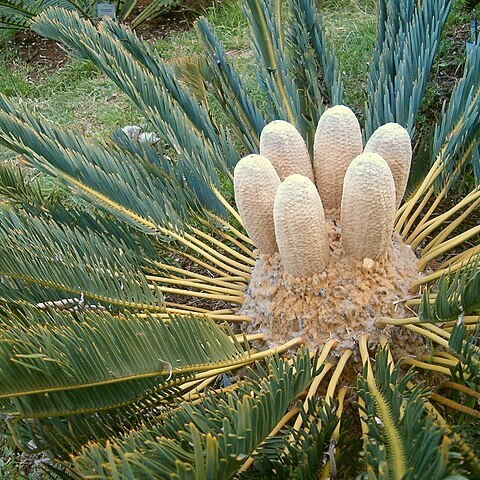Plant unbranched or branched from the base; stems stout, up to about 4 m tall, 35-60 cm diam., eventually leaning or procumbent with age, with open densely brown woolly crown; interseriate bracts linear-lanceolate, up to 14 cm long, densely woolly on outer surface. Leaves 1-1.2 m long including petiole about 30 cm long, undersurface of rhachis and margins of leaflets loosely whitish woolly when young, glabrescent, with pulvinus persistently woolly; rhachis fairly stiff, straight or recurved, often spreading lower than crown when stem has cones; leaflets somewhat glaucous when young, closely spaced and overlapping in the upper half of leaf and in V disposition, linear, shortly narrowed to an amber, dark brown or black pungent apex, with entire thickened margins, and with the basal ones reduced in size, but not to prickles; median leaflets 10-17 cm long and about 7 mm broad, with 7-9 prominent nerves on the lower surface. Cones 3-several together (up to 10 on large male stems) on short stout peduncles, and with a dense yellowish-grey to brownish woolly covering. Male cones cylindric, curved, 20-30 cm long, 6-7 cm diam.; median scales about 2.5-2.8 cm long and 2 cm broad with beak projecting about 5 mm beyond sporangial margin and turned slightly upwards; bulla face terminating in a narrow blunt facet under the woolly covering. Female cones more or less oblong in outline with rounded apex, 25-30 cm long and 15-17 cm diam.; median scales 4.5-5 cm long; the bulla about 4.5 cm broad and 2.5 cm thick vertically, with short incurved lateral lobes 6-8 mm long; bulla face pale canary-yellow under the wool, elliptic-rhomboid with more or less acute lateral ridges; upper and lower facets broadly rounded, terminal facet flattened, about 1 cm broad and 5 mm wide vertically. Seeds pale yellow to pale orange-yellow, 3 cm long and 2 cm diam., angled by compression.
More
Plant dioecious, palm-like. Stem aerial or decumbent, 1-5 m tall, unbranched or branched from base, covered by alternating series of woolly bracts and persistent swollen truncated leaf bases. Leaves petiolate, pinnate with rachis straight and perpendicular to trunk; leaflets pungent-pointed, entire, margins markedly thickened; reduced in size towards base of rachis. Cones June-Dec., appear sessile, densely woolly. Male cones 3-12, lanceoloid. Female cones 3-6, cylindric to ovoid, broader than male.


